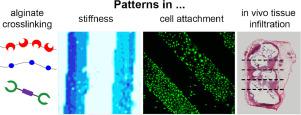Acta Biomaterialia ( IF 9.4 ) Pub Date : 2020-07-28 , DOI: 10.1016/j.actbio.2020.07.047 Aline Lueckgen 1 , Daniela S Garske 2 , Agnes Ellinghaus 1 , David J Mooney 3 , Georg N Duda 4 , Amaia Cipitria 5

|
Hydrogels with patterned biophysical and biochemical properties have found increasing attention in the biomaterials community. In this work, we explore alginate-based materials with two orthogonal crosslinking mechanisms: the spontaneous Diels-Alder reaction and the ultraviolet light-initiated thiol-ene reaction. Combining these mechanisms in one material and spatially restricting the location of the latter using photomasks, enables the formation of dual-crosslinked hydrogels with patterns in stiffness, biomolecule presentation and degradation, granting local control over cell behavior. Patterns in stiffness are characterized morphologically by confocal microscopy and mechanically by uniaxial compression and microindentation measurement. Mouse embryonic fibroblasts seeded on stiffness-patterned substrates attach preferably and attain a spread morphology on stiff compared to soft regions. Human mesenchymal stem cells demonstrate preferential adipogenic differentiation on soft surfaces and osteogenic differentiation on stiff surfaces. Patterns in biomolecule presentation reveal favored attachment of mouse pre-osteoblasts on stripe regions, where thiolated cell-adhesive biomolecules have been coupled. Patterns in degradation are visualized by microindentation measurement following collagenase exposure. Patterned tissue infiltration into degradable regions on the surface is discernible in n=5/12 samples, when these materials are implanted subcutaneously into the backs of mice. Taken together, these results demonstrate that our hydrogel system with patterns in biophysical and biochemical properties enables the study of how environmental cues affect multiple cell behaviors in vitro and could be applied to guide endogenous tissue growth in diverse healing scenarios in vivo.
Statement of Significance
Hydrogels with patterns in biophysical and biochemical properties have been explored in the biomaterials community in order to spatially control or guide cell behavior. In our alginate-based system, we demonstrate the effect of local substrate stiffness and biomolecule presentation on the in vitro cell attachment, morphology, migration and differentiation behavior of two different mouse cell lines and human primary cells. Additionally, the effect of degradation patterns on the in vivo tissue infiltration is analyzed following subcutaneous implantation into a mouse model. The achievement of patterned tissue infiltration following the hydrogel template represents an important step towards guiding endogenous healing responses, thus inviting application in various tissue engineering contexts.
中文翻译:

双重藻酸盐交联,用于生物物理和生化特性的局部图案化。
具有图案化的生物物理和生化特性的水凝胶在生物材料界越来越受到关注。在这项工作中,我们探索具有两种正交交联机制的藻酸盐基材料:自发的Diels-Alder反应和紫外线引发的硫醇-烯反应。将这些机制结合在一种材料中,并使用光掩模在空间上限制后者的位置,可以形成具有刚性,生物分子呈递和降解模式的双交联水凝胶,从而可以对细胞行为进行局部控制。通过共聚焦显微镜在形态学上表征刚度的图案,并且通过单轴压缩和微压痕测量在力学上表征图案。与软区域相比,播种在刚度图案底物上的小鼠胚胎成纤维细胞可更好地附着并在刚度上获得扩展形态。人间充质干细胞在软表面表现出优先的成脂分化,在硬表面表现出成骨的分化。生物分子呈递模式揭示了小鼠前成骨细胞在硫醇化细胞粘附性生物分子已经偶联的条纹区域上的附着性。通过胶原酶暴露后的微压痕测量,可以看到降解模式。当将这些材料皮下植入小鼠背部时,在n = 5/12的样品中可以看到图案化的组织浸润到表面可降解区域中。在一起
重要声明
为了在空间上控制或指导细胞行为,在生物材料界已经探索了具有生物物理和生化特性模式的水凝胶。在基于藻酸盐的系统中,我们证明了局部底物刚度和生物分子呈递对两种不同小鼠细胞系和人类原代细胞的体外细胞附着,形态,迁移和分化行为的影响。另外,在皮下植入小鼠模型后,分析了降解模式对体内组织浸润的影响。在水凝胶模板之后实现图案化组织浸润代表了朝着指导内源性愈合反应迈出的重要一步,从而促使其在各种组织工程环境中的应用。











































 京公网安备 11010802027423号
京公网安备 11010802027423号